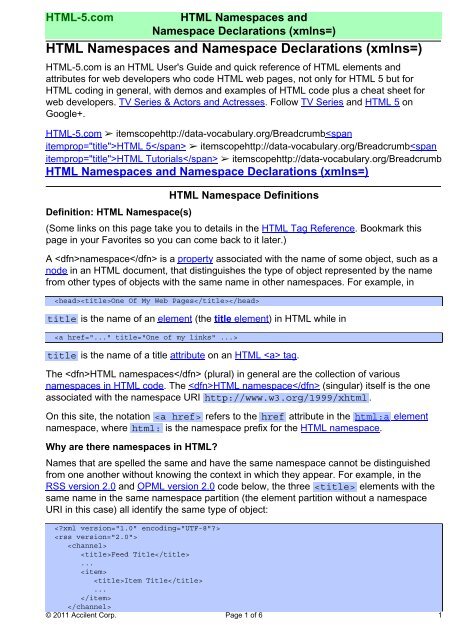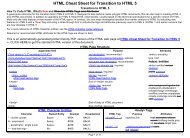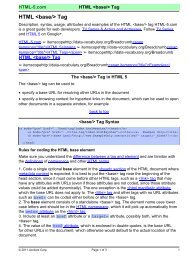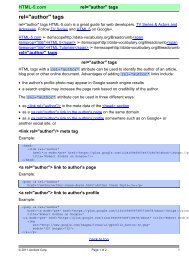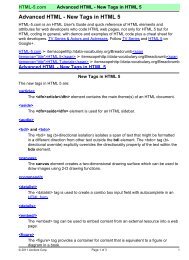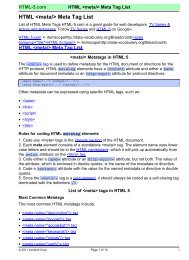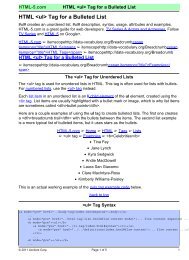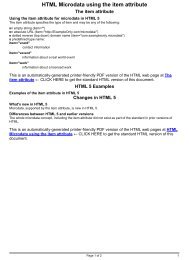HTML Namespaces and Namespace Declarations (ns=)
HTML Namespaces and Namespace Declarations (ns=)
HTML Namespaces and Namespace Declarations (ns=)
Create successful ePaper yourself
Turn your PDF publications into a flip-book with our unique Google optimized e-Paper software.
<strong>HTML</strong>-5.com<br />
<strong>HTML</strong> <strong><strong>Namespace</strong>s</strong> <strong>and</strong><br />
<strong>Namespace</strong> <strong>Declarations</strong> (xml<strong>ns=</strong>)<br />
<strong>HTML</strong> <strong><strong>Namespace</strong>s</strong> <strong>and</strong> <strong>Namespace</strong> <strong>Declarations</strong> (xml<strong>ns=</strong>)<br />
<strong>HTML</strong>-5.com is an <strong>HTML</strong> User's Guide <strong>and</strong> quick reference of <strong>HTML</strong> elements <strong>and</strong><br />
attributes for web developers who code <strong>HTML</strong> web pages, not only for <strong>HTML</strong> 5 but for<br />
<strong>HTML</strong> coding in general, with demos <strong>and</strong> examples of <strong>HTML</strong> code plus a cheat sheet for<br />
web developers. TV Series & Actors <strong>and</strong> Actresses. Follow TV Series <strong>and</strong> <strong>HTML</strong> 5 on<br />
Google+.<br />
<strong>HTML</strong>-5.com ➢ itemscopehttp://data-vocabulary.org/Breadcrumb<strong>HTML</strong> 5 ➢ itemscopehttp://data-vocabulary.org/Breadcrumb<strong>HTML</strong> Tutorials ➢ itemscopehttp://data-vocabulary.org/Breadcrumb<br />
<strong>HTML</strong> <strong><strong>Namespace</strong>s</strong> <strong>and</strong> <strong>Namespace</strong> <strong>Declarations</strong> (xml<strong>ns=</strong>)<br />
Definition: <strong>HTML</strong> <strong>Namespace</strong>(s)<br />
<strong>HTML</strong> <strong>Namespace</strong> Definitions<br />
(Some links on this page take you to details in the <strong>HTML</strong> Tag Reference. Bookmark this<br />
page in your Favorites so you can come back to it later.)<br />
A namespace is a property associated with the name of some object, such as a<br />
node in an <strong>HTML</strong> document, that distinguishes the type of object represented by the name<br />
from other types of objects with the same name in other namespaces. For example, in<br />
One Of My Web Pages<br />
title is the name of an element (the title element) in <strong>HTML</strong> while in<br />
<br />
title is the name of a title attribute on an <strong>HTML</strong> tag.<br />
The <strong>HTML</strong> namespaces (plural) in general are the collection of various<br />
namespaces in <strong>HTML</strong> code. The <strong>HTML</strong> namespace (singular) itself is the one<br />
associated with the namespace URI http://www.w3.org/1999/xhtml .<br />
On this site, the notation refers to the href attribute in the html:a element<br />
namespace, where html: is the namespace prefix for the <strong>HTML</strong> namespace.<br />
Why are there namespaces in <strong>HTML</strong>?<br />
Names that are spelled the same <strong>and</strong> have the same namespace cannot be distinguished<br />
from one another without knowing the context in which they appear. For example, in the<br />
RSS version 2.0 <strong>and</strong> OPML version 2.0 code below, the three elements with the<br />
same name in the same namespace partition (the element partition without a namespace<br />
URI in this case) all identify the same type of object:<br />
<br />
<br />
<br />
Feed Title<br />
...<br />
<br />
Item Title<br />
...<br />
<br />
<br />
© 2011 Accilent Corp. Page 1 of 6 1
<strong>HTML</strong> <strong><strong>Namespace</strong>s</strong> <strong>and</strong><br />
<strong>Namespace</strong> <strong>Declarations</strong> (xml<strong>ns=</strong>)<br />
<strong>HTML</strong>-5.com<br />
<br />
<br />
<br />
My OPML<br />
<br />
<br />
...<br />
<br />
<br />
In order to differentiate the title elements above you would have to know that the first<br />
one was a descendant of an rss element <strong>and</strong> channel element; the second was a<br />
descendant of an rss element, channel element <strong>and</strong> item element; <strong>and</strong> the third was a<br />
descendant of an opml element <strong>and</strong> a head element.<br />
In addition, without namespaces there might be elements with the same element name<br />
that have different meanings or content depending on where they are used. Their different<br />
models would have to be combined to create a single definition (XML Schema definition or<br />
DTD) of the element. This might work if all meanings were determined by the same entity,<br />
but it would likely be a major issue if different st<strong>and</strong>ards bodies or industry groups were<br />
involved.<br />
This type of confusion in XML content without namespaces makes it very difficult to<br />
aggregate that content into other types of content, even if the other content formats do<br />
support namespaces. For example, if portions of the content above was included in an<br />
<strong>HTML</strong> document (without overriding the namespace with xml<strong>ns=</strong>"" ), the title elements<br />
would be treated as a valid <strong>HTML</strong> titles, the head element <strong>and</strong> body element would be<br />
treated as duplicates of their <strong>HTML</strong> counterparts <strong>and</strong> most of the other elements would be<br />
treated as invalid <strong>HTML</strong> code.<br />
Note that the <strong>HTML</strong> title element would not be confused with the title elements<br />
shown above, since its name is in a different namespace partition associated with the <strong>HTML</strong><br />
namespace URI.<br />
back to top<br />
<strong>Namespace</strong> Partitions<br />
For each namespace, including the one with no namespace URI, there are a number of<br />
namespace partitions:<br />
• an element name partition for the names of element types<br />
• for each element type, a separate element attribute name partition for the<br />
names of local attributes specific to that element type<br />
• a global attribute name partition for the names of global attributes that can be<br />
used on any type of element, regardless of which namespace contains the element name<br />
Since those partitions exist for each namespace, the collection of namespace partitions can<br />
be viewed as a two-dimensional table:<br />
<strong>Namespace</strong> URI Prefix Element Names Element<br />
Attribute Names<br />
Global Attribute<br />
Names<br />
2 Page 2 of 6 © 2011 Accilent Corp.
<strong>HTML</strong>-5.com<br />
(in<br />
xmlns<br />
attribute)<br />
none<br />
( xml<strong>ns=</strong>"" )<br />
none<br />
http://<br />
default (no<br />
xhtml<br />
prefix)<br />
http://<br />
www.w3.org/<br />
XML/1998/<br />
namespace<br />
<strong>HTML</strong> <strong><strong>Namespace</strong>s</strong> <strong>and</strong><br />
<strong>Namespace</strong> <strong>Declarations</strong> (xml<strong>ns=</strong>)<br />
xml:<br />
reserved<br />
http://<br />
xmlns:<br />
www.w3.org/2000/ reserved<br />
xmlns/<br />
title (in RSS,<br />
OPML, etc.)<br />
<br />
<br />
http://<br />
xsd: for<br />
<br />
www.w3.org/2001/ the <strong>HTML</strong><br />
examples on this<br />
site<br />
http://<br />
xsi: for<br />
www.w3.org/2001/ the on this<br />
site<br />
<br />
<br />
<br />
<br />
<br />
<br />
<br />
<br />
<br />
<br />
<br />
<strong>HTML</strong> global<br />
attributes such<br />
as id <strong>and</strong><br />
style<br />
xml:lang<br />
xml:space<br />
default<br />
namespace<br />
( xml<strong>ns=</strong> ) <strong>and</strong><br />
namespace<br />
prefix<br />
declarations<br />
( xmlns:xxx=)<br />
xsi:type<br />
© 2011 Accilent Corp. Page 3 of 6 3
<strong>HTML</strong> <strong><strong>Namespace</strong>s</strong> <strong>and</strong><br />
<strong>Namespace</strong> <strong>Declarations</strong> (xml<strong>ns=</strong>)<br />
http://<br />
math: for <br />
www.w3.org/1998/ the <strong>HTML</strong><br />
examples on this<br />
site<br />
http://<br />
rdf: for<br />
rdf:RDF<br />
www.w3.org/1999/02/22- the <strong>HTML</strong>rdf:List<br />
examples on this<br />
site<br />
http://<br />
rdfs: for rdfs:Datatype<br />
www.w3.org/2000/01/ the <strong>HTML</strong><br />
examples on this<br />
site<br />
http://<br />
svg: for<br />
<br />
www.w3.org/2000/ the <strong>HTML</strong><br />
examples on this<br />
site<br />
<br />
<br />
<br />
<br />
<strong>HTML</strong>-5.com<br />
rdf:about<br />
When designing schema for one or more sets of objects, you should ensure that no<br />
namespace partition (as shown in the table above) contains the same name for two different<br />
object types. Otherwise, it will be difficult to create a definition (XML Schema definition<br />
or DTD) that properly describes the schema. For example, in the table above the title<br />
element in the "no namespace URL" partition violates this requirement because it is used for<br />
RSS channel titles, RSS item titles <strong>and</strong> OPMN titles.<br />
http://www.w3.org/1999/xhtml<br />
<strong>and</strong> other <strong>HTML</strong> <strong><strong>Namespace</strong>s</strong><br />
The namespace URIs in <strong>HTML</strong> documents<br />
back to top<br />
Commonly used namespaces in <strong>HTML</strong> include:<br />
http://www.w3.org/XML/1998/namespace<br />
the URI for the XML base namespace; associated with the implicitly declared reserved<br />
prefix xml:<br />
http://www.w3.org/2000/xmlns/<br />
the namespace URI for XML namespace declarations; associated with the implicitly<br />
declared reserved prefix xmlns:<br />
4 Page 4 of 6 © 2011 Accilent Corp.
<strong>HTML</strong>-5.com<br />
http://www.w3.org/1999/xhtml<br />
<strong>HTML</strong> <strong><strong>Namespace</strong>s</strong> <strong>and</strong><br />
<strong>Namespace</strong> <strong>Declarations</strong> (xml<strong>ns=</strong>)<br />
the URI for the <strong>HTML</strong> namespace, the same namespace URI defined by the<br />
2000-2010 Recommendations from the W3C <strong>HTML</strong> Working Group; implicitly declared<br />
as the default namespace for unprefixed tag names when document is being parsed<br />
as <strong>HTML</strong>, but explicitly coding it is recommended for cases when document is being<br />
parsed as x<strong>HTML</strong> or XML<br />
http://www.w3.org/1998/Math/MathML<br />
the MathML namespace for MathML tags<br />
http://www.w3.org/1999/02/22-rdf-syntax-ns#<br />
the RDF namespace for RDF tags<br />
http://www.w3.org/2000/01/rdf-schema#<br />
the RDF schema namespace<br />
http://www.w3.org/2000/svg<br />
the SVG namespace for SVG tags<br />
http://www.w3.org/1999/xlink<br />
the XLink namespace<br />
http://www.w3.org/2001/XMLSchema<br />
the namespace for XML Schema Definitions, which are XML documents<br />
that replace non-XML DTDs<br />
http://www.w3.org/2001/XMLSchema-instance<br />
the namespace for XML Schema instance documents, which can be used to specify<br />
whether the data for a field is binary (possibly encrypted) or plain text:<br />
4321 **** ****<br />
➥ 8765<br />
BAM0NCo<br />
➥ mFzC2TOsmRzW0NTueQU==<br />
http://www.w3.org/1999/XSL/Transform<br />
the namespace for XSL style sheets, which is not used in <strong>HTML</strong> documents<br />
themselves, but is used in the style sheet documents that are referenced by the xmlstylesheet<br />
instruction <strong>and</strong> contain XSLT elements intermingled with <strong>HTML</strong> code.<br />
back to top<br />
xmlns namespace declarations in the tag<br />
How to declare namespaces in an <strong>HTML</strong> document<br />
The easiest way to declare namespaces is by putting the xmlns attributes in the top<br />
element of the XML document, which in this case is the tag:<br />
<strong>HTML</strong> <strong><strong>Namespace</strong>s</strong> <strong>and</strong><br />
<strong>Namespace</strong> <strong>Declarations</strong> (xml<strong>ns=</strong>)<br />
<strong>HTML</strong>-5.com<br />
In <strong>HTML</strong> 5, all elements (<strong>HTML</strong> tags) are automatically considered to be qualified with the<br />
<strong>HTML</strong> 5 namespace, which makes the declaration of the <strong>HTML</strong> namespace optional, but<br />
this only works with <strong>HTML</strong> browsers with <strong>HTML</strong> 5 support that are parsing the web page<br />
as an <strong>HTML</strong> version 5 document. It's best to continue<br />
coding the xml<strong>ns=</strong>"http://www.w3.org/1999/xhtml" xmlns attribute explicitly to<br />
provide backward compatibility with browsers lacking full <strong>HTML</strong> 5 support <strong>and</strong> other types of programs that may be processing <strong>HTML</strong> documents, such<br />
as RSS feed readers <strong>and</strong> generic XML parsers - otherwise all of the <strong>HTML</strong> tags will appear<br />
to be in the partition with no namespace URI.<br />
back to top<br />
THE END<br />
6 Page 6 of 6 © 2011 Accilent Corp.


